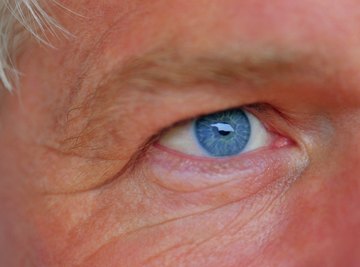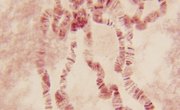
Genotype and phenotype describe aspects of the discipline of genetics, which is the science of heredity, genes and variation in organisms. Genotype is the full extent of an organism’s heredity information, whereas phenotype refers to an organism’s observable characteristics, such as structure and behavior. DNA, or deoxyribonucleic acid, is responsible for genotype and partially responsible, along with the environment, for phenotype.
Genotype
DNA is the inherited genetic substance passed down from one generation to the next. It is a long molecule composed of repeating sugar-phosphate groups in which one of four nucleotide bases -- nitrogenous molecular rings --hangs off each sugar group. The genetic code maps sequences of three adjacent DNA bases, known as codons, to the building blocks of proteins, amino acids. Cells organize and maintain DNA and associated proteins in chromosomes. Each species has a characteristic number of chromosomes. For example, each human cell, except for sex cells, has 46 chromosomes -- the diploid number -- packaged as 23 pairs. You inherit one set of 23 from each parent through sexual reproduction. Sex cells have a single set of chromosomes -- the haploid number -- that merge and form pairs after fertilization, thereby restoring the diploid number. Asexual creatures, such as bacteria, normally have just one chromosome, although they may keep a few extra copies of the single chromosome and may have additional snippets of DNA called plasmids. Before a cell can divide, it must make a copy of its DNA so that it can distribute the full genotype to each daughter cell.
Gene Expression
Genes are the portions of chromosomes that contain the code for making proteins. Only a portion of each chromosome codes for proteins -- in humans, 98 percent of chromosomal real estate performs some other tasks, such as creating structural ribonucleic acid (RNA), controlling gene operation or, in the case of junk DNA, simply occupying space. Your genotype is the sum total of the information in your genes. Proteins are responsible for your physical characteristics and, as enzymes, for your biochemical activities. Therefore, the expression of genes as proteins governs a large proportion of your phenotype. Environmental factors can influence gene expression, physical structure, intelligence and behavior. Diploid organisms have two copies or each gene, called alleles, and the relative activity of each allele influences the organism’s phenotype.
The Causes of Genotype
No one knows how DNA became the universal carrier of the genetic code, or indeed how the genetic code came into being. Many scientists ascribe to the RNA World Hypothesis, in which RNA took on the primary genetic role in Earth’s earliest living creatures, when chemicals first organized themselves into life forms. At some point, DNA assumed this key role. Organisms developed the ability to replicate their DNA molecules, distribute copies to offspring, and conserve the informational content of DNA through the generations. Evolution, spurred on by adaptation to the environment, mutation, natural selection and survival of the fittest, lead to more complex species with larger genotypes. Although scientists have a deep understanding of rhe processes that maintain a species’ genotype, such as DNA replication, gene expression and reproduction, the root cause of why life and genotypes first came about remains clouded in mystery.
Phenotype
Phenotype, such as the color of hair and eyes, is expressed in part through the processes of transcription and translation. In transcription, the cell copies the gene-encoded information to the molecule messenger RNA (mRNA). Translation is the process by which the cell synthesizes proteins by reading mRNA strands and stringing together the appropriate amino acids. Many sophisticated mechanisms have evolved to control which genes are expressed in various cells, tissues and organs, when expression occurs, and which alleles dominate over other alleles. For example, if you have one allele for brown eyes and one allele for blue eyes, you’ll have brown eyes because the brown-eye gene is dominant. Although the phenotype is largely based on genotype, many factors, including the environment, injuries, diseases and experience can have a profound effect on an individual’s phenotype. For example, a prenatal nutritional deficiency could interfere with the expression of genes or with the activity of enzymes during development, creating a permanent change to an organism’s phenotype.
References
About the Author
Based in Greenville SC, Eric Bank has been writing business-related articles since 1985. He holds an M.B.A. from New York University and an M.S. in finance from DePaul University. You can see samples of his work at ericbank.com.
Photo Credits
Jupiterimages/Stockbyte/Getty Images
